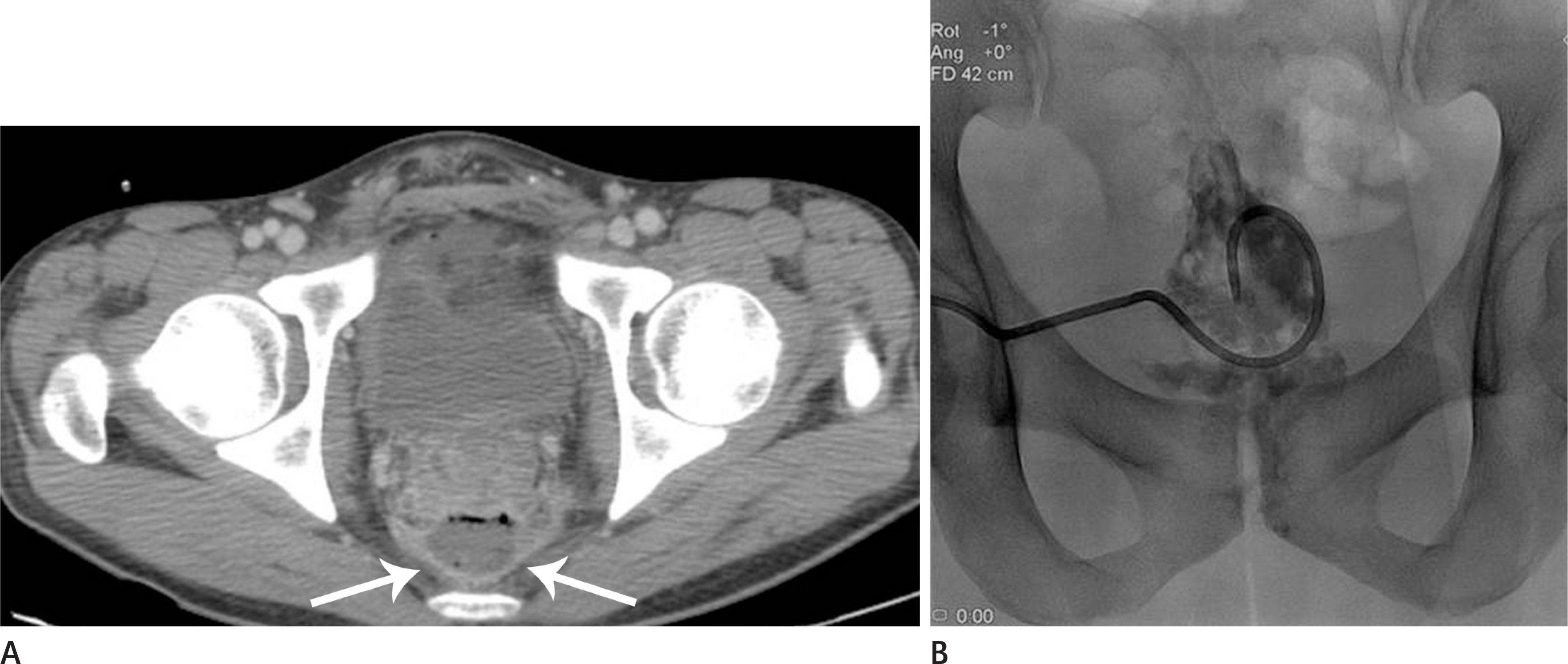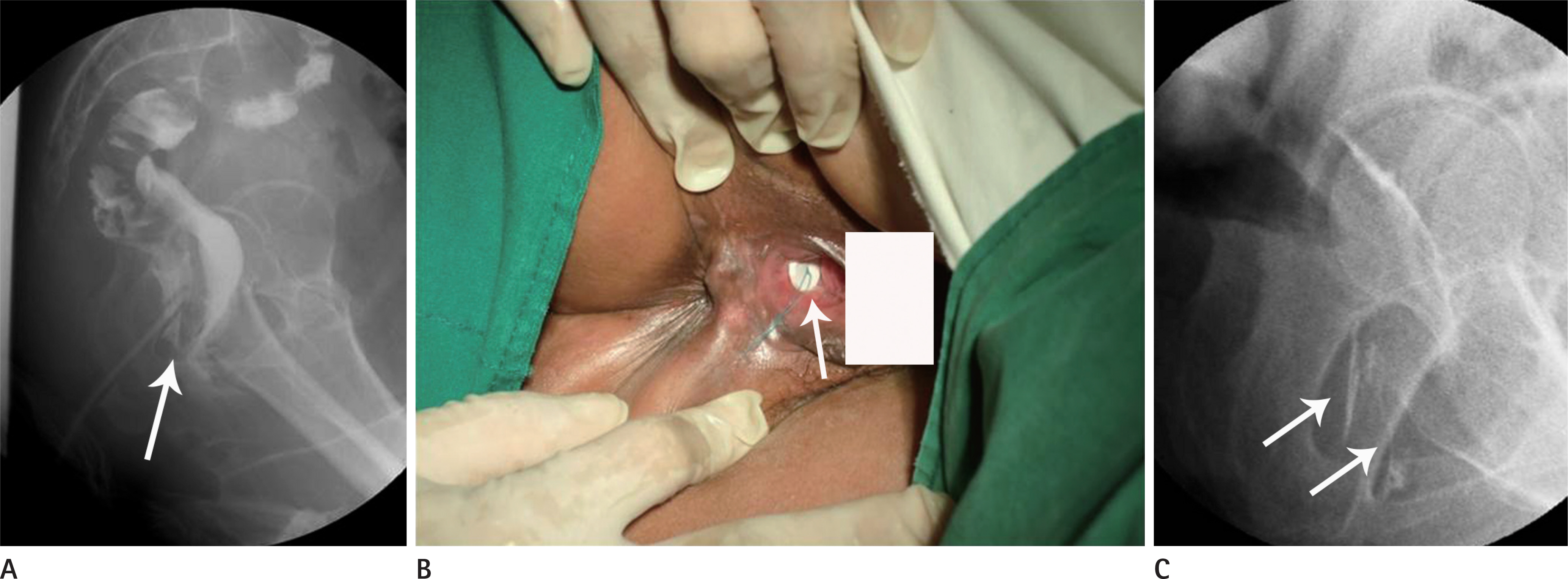J Korean Soc Radiol.
2018 Jan;78(1):49-62. 10.3348/jksr.2018.78.1.49.
Clinical Findings and Interventional Treatment of Gastrointestinal Fistulae: Pictorial Essay
- Affiliations
-
- 1Department of Radiology, College of Medicine, Kyung Hee University, Seoul, Korea. Kwon98@khu.ac.kr
- 2Department of Radiology, Kyung Hee University Hospital at Gangdong, Seoul, Korea.
- KMID: 2399306
- DOI: http://doi.org/10.3348/jksr.2018.78.1.49
Abstract
- Gastrointestinal (GI) fistulae are defined as an abnormal communication between the gastrointestinal tract and the skin and/or the epithelial surface of an adjacent viscus. GI fistulae are the most feared complications caused by a variety of medical conditions including abdominal surgery, inflammatory bowel disease, abscess, radiation, or trauma. The management of GI fistulae is complex and requires a detailed, stepwise approach to achieve successful closure. The ultimate goal of management is to re-establish the continuity of the GI tract, while limiting the morbidity and mortality. Interventional radiology can play an important role in the diagnosis and treatment of GI fistulae. In this article, we review the clinical and radiologic features and interventional treatment of GI fistulae.
MeSH Terms
Figure
Reference
-
References
1. Falconi M, Pederzoli P. The relevance of gastrointestinal fistulae in clinical practice: a review. Gut. 2001; 49(Suppl 4):iv2–iv10.
Article2. González-Pinto I, González EM. Optimising the treatment of upper gastrointestinal fistulae. Gut. 2001; 49(Suppl 4):iv22–iv31.
Article3. Kumar M, Anjum S. A study on enterocutaneous fistula. Indian J Appl Res. 2016; 6:417–418.4. Aguirre A, Fischer JE, Welch CE. The role of surgery and hy-peralimentation in therapy of gastrointestinal-cutaneous fistulae. Ann Surg. 1974; 180:393–401.
Article5. Rose D, Yarborough MF, Canizaro PC, Lowry SF. One hundred and fourteen fistulas of the gastrointestinal tract treated with total parenteral nutrition. Surg Gynecol Obstet. 1986; 163:345–350.6. Kang DB, Kim JM, Kim HS. Management of Enterocutaneous Fistula. J Korean Surg Soc. 2000; 58:816–823.7. Cho CK, Chun HJ. Clinical analysis of enterocutaneous fistula. J Korean Surg Soc. 1993; 45:503–509.8. Taggarshe D, Bakston D, Jacobs M, McKendrick A, Mittal VK. Management of enterocutaneous fistulae: a 10 years experience. World J Gastrointest Surg. 2010; 2:242–246.
Article9. Roozrokh HC, Ripepi A, Stahlfeld K. Gastrocolocutaneous fistula as a complication of peg tube placement. Surg Endosc. 2002; 16:538–539.
Article10. McLean GK, Mackie JA, Freiman DB, Ring EJ. Enterocutaneous fistulae: interventional radiologic management. Am J Roentgenol. 1982; 138:615–619.
Article11. D'Harcour JB, Boverie JH, Dondelinger RF. Percutaneous management of enterocutaneous fistulas. AJR Am J Roentgenol. 1996; 167:33–38.12. Berry SM, Fischer JE. Enterocutaneous fistulas. Curr Probl Surg. 1994; 31:469–566.
Article13. Malangoni MA, Madura JA, Jesseph JE. Management of lateral duodenal fistulas: a study of fourteen cases. Surgery. 1981; 90:645–651.14. Berry SM, Fischer JE. Classification and pathophysiology of enterocutaneous fistulas. Surg Clin North Am. 1996; 76:1009–1018.
Article15. Disa JJ, Goldberg NH, Carlton JM, Robertson BC, Slezak S. Restoring abdominal wall integrity in contaminated tissue-deficient wounds using autologous fascia grafts. Plast Reconstr Surg. 1998; 101:979–986.
Article16. Baars JE, Kuipers EJ, Dijkstra G, Hommes DW, de Jong DJ, Stokkers PC, et al. Malignant transformation of perianal and enterocutaneous fistulas is rare: results of 17 years of follow-up from The Netherlands. Scand J Gastroenterol. 2011; 46:319–325.
Article17. Evenson AR, Fischer JE. Current management of enterocutaneous fistula. J Gastrointest Surg. 2006; 10:455–464.
Article18. Draus JM Jr, Huss SA, Harty NJ, Cheadle WG, Larson GM. Enterocutaneous fistula: are treatments improving? Surgery. 2006; 140:570–576. discussion 576–578.
Article19. Reber HA, Roberts C, Way LW, Dunphy JE. Management of external gastrointestinal fistulas. Ann Surg. 1978; 188:460–467.
Article20. Sancho JJ, di Costanzo J, Nubiola P, Larrad A, Beguiristain A, Roqueta F, et al. Randomized double-blind placebocontrolled trial of early octreotide in patients with postoperative enterocutaneous fistula. Br J Surg. 1995; 82:638–641.
Article21. Alvarez C, McFadden DW, Reber HA. Complicated enterocutaneous fistulas: failure of octreotide to improve healing. World J Surg. 2000; 24:533–537. ; discussion 538.
Article22. Hollington P, Mawdsley J, Lim W, Gabe SM, Forbes A, Windsor AJ. An 11-year experience of enterocutaneous fistula. Br J Surg. 2004; 91:1646–1651.
Article23. Owen RM, Love TP, Perez SD, Srinivasan JK, Sharma J, Pollock JD, et al. Definitive surgical treatment of enterocutaneous fistula: outcomes of a 23-year experience. JAMA Surg. 2013; 148:118–126.24. Trevino JM, Drelichman ER, Varadarajulu S. Modified technique for EUS-guided drainage of pelvic abscess (with video). Gastrointest Endosc. 2008; 68:1215–1219.
Article25. Rahman FN, Stavas JM. Interventional radiologic management and treatment of enterocutaneous fistulae. J Vasc Interv Radiol. 2015; 26:7–19. ; quiz 20.
Article26. LaBerge JM, Kerlan RK Jr, Gordon RL, Ring EJ. Nonoperative treatment of enteric fistulas: results in 53 patients. J Vasc Interv Radiol. 1992; 3:353–357.
Article27. Varadarajulu S, Drelichman ER. Effectiveness of EUS in drainage of pelvic abscesses in 25 consecutive patients (with video). Gastrointest Endosc. 2009; 70:1121–1127.
Article28. Han JK. Percutaneous abdominal abscess drainage. In Han MC, Park JH, eds. Interventional radiology. Seoul: Ilchokak;2006. p. 707–714.29. Grunshaw ND, Ball CS. Palliative treatment of an enterorec-tal fistula with a covered metallic stent. Cardiovasc Intervent Radiol. 2001; 24:438–440.
Article30. Kang YJ, Oh JH, Yoon Y, Kim EJ, Ryu KN, Lim JW, et al. Covered metallic stent placement in the treatment of postoperative fistula resistant to conservative management after Billroth I operation. Cardiovasc Intervent Radiol. 2005; 28:90–92.
Article31. Rábago LR, Ventosa N, Castro JL, Marco J, Herrera N, Gea F. Endoscopic treatment of postoperative fistulas resistant to conservative management using biological fibrin glue. Endoscopy. 2002; 34:632–638.
Article32. Jones PM, Segal SH, Gelb AW. Venous oxygen embolism produced by injection of hydrogen peroxide into an enterocutaneous fistula. Anesth Analg. 2004; 99:1861–1863.
Article33. Passage J, Tam R, Windsor M, O'Brien M. Bioglue: a review of the use of this new surgical adhesive in thoracic surgery. ANZ J Surg. 2005; 75:315–318.
Article34. Lisle DA, Hunter JC, Pollard CW, Borrowdale RC. Percutaneous gelfoam embolization of chronic enterocutaneous fistulas: report of three cases. Dis Colon Rectum. 2007; 50:251–256.
Article
- Full Text Links
- Actions
-
Cited
- CITED
-
- Close
- Share
- Similar articles
-
- Pictorial, Essay : Sonography of the Stomach
- The Role of Interventional Radiology in Treatment of Patients with Acute Trauma: A Pictorial Essay
- Imaging Features of the Mesenchymal Tumors of the Breast according to WHO Classification: A Pictorial Essay
- Postoperative Imaging Findings of Colorectal Surgery: A Pictorial Essay
- Multi-Detector CT Findings of Typical and Atypical Appendicitis: A Pictorial Essay













